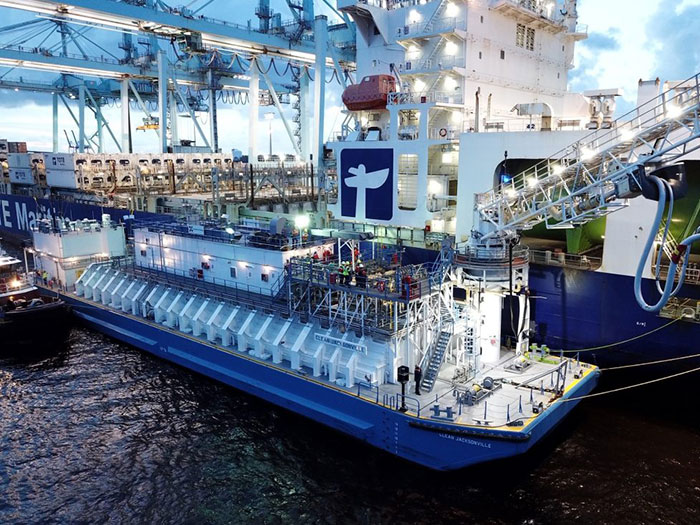
Op-Ed: BioLNG is in use and provides flexible CII compliance backed by green finance
Written by
In September 2021 JAXLNG together with Element Markets supplied a bioLNG blend to Tote’s Isla Bella in Jacksonville, Florida, completing the first bioLNG bunkering in the U.S.
by Steve Esau, chief operating officer, SEA-LNG

BioLNG is available now. Suppliers are quoting prices for delivery of bioLNG bunkers in Rotterdam, the biggest marine fuel bunkering hub in Europe, and in a number of North Sea and Baltic Sea ports. The number of locations worldwide where bioLNG can be bunkered is expanding every day.
The world’s largest LNG-fueled vessel, the CMA CGM Jacques Saade used a 13% bioLNG mix from TotalEnergies when refueling in Rotterdam as early as 2020. In September 2021 JAX LNG together with Element Markets supplied a bioLNG blend to Tote’s Isla Bella in Jacksonville, Florida, completing the first bioLNG bunkering in the U.S. Meanwhile in June 2021 Baleària’s fast ferry Eleanor Roosevelt completed its first trip operating on 100% bioLNG.
BioLNG is a drop-in fuel. This means that it can be used in current LNG infrastructure and LNG-fueled vessels with no adaptations required. This ability to transport, store and bunker bioLNG with existing infrastructure means it can immediately be used on vessels in line with production.
BioLNG production is scaling up. In December 2021, Titan, Attero, and Nordsol were awarded EUR 4.3 million (about $4.4 million) in funding from the EU for their FirstBio2Shipping bioLNG production plant which is due to come onstream in 2023. The plant, located at the Attero facility in Wilp, the Netherlands, will produce around 2,400 tonnes per year of bioLNG for use as a marine fuel. EveRé, Elengy, TotalEnergies and CMA CGM Group are collaborating at Marseille-Fos Port to produce bioLNG from household waste. They expect this bioLNG to reduce GHG emissions from CMA CGM dual-fuel vessels by at least 67% on a well-to-wake basis compared to VLSFO.
Flexibility in meeting CII
Regulations such as the International Maritime Organization’s (IMO) carbon intensity indicator (CII) are set to shake up emissions clauses in charterparty agreements in 2022 and beyond.
Recent analysis from SEA-LNG found that LNG-fueled vessels will be able to continue operating as normal under the system until after 2030, while traditional LNG blended with bioLNG or renewable synthetic LNG will extend compliance to 2050 and beyond.
For every 10% increase in the content of bioLNG or renewable synthetic LNG in a blend with traditional LNG, a vessel gains two-years of additional compliance. By introducing bioLNG and renewable synthetic LNG, a vessel commissioned yesterday, today and in the future can retain a favorable CII rating as major superior A or superior B throughout its lifetime.
This ability to blend LNG with bioLNG right now, and in the longer-term with renewable synthetic LNG (e-LNG), provides unrivalled flexibility. With CII thresholds tightening annually, bioLNG can be introduced incrementally to the vessel’s fuel mix as required to achieve or maintain a specific CII rating, such as a “major superior” A-rating.
Green Financing
The appetite of banks for climate-aligned investments also plays a key role in the transition from LNG to bioLNG. While LNG already provides a competitive advantage for owners seeking preferable lower cost finance through the Poseidon Principles, bioLNG goes even further.
Analysis from SEA-LNG performed last year determined that for every 10% of bioLNG dropped in and blended with LNG as a marine fuel, a vessel can achieve two extra years’ compliance with the Annual Efficiency Ratio (AER) curve used to secure funding under the Poseidon Principles.
Investors are increasingly recognising that investments in LNG are both green and secure. They recognize that an investment in LNG not only delivers benefits today, but offers an incremental, low risk and practical pathway for maritime decarbonisation.
As an example, Société Générale recently facilitated financing to Pan Ocean for one of the world’s first purpose-built LNG bunkering vessels. Since this vessel can also bunker bioLNG and renewable synthetic LNG, the investment is in a future-proof asset. With investment in LNG going back over 50 years, this Pan Ocean vessel fits in with infrastructure and supply chains that are already mature and funded to a large extent, and to a much greater extent than alternatives, which still require trillions of dollars of investment.
To summarize, bioLNG is already in use and production is scaling up further, it offers a flexible way of achieving long-term competitive advantage under CII, and it is an attractive investment for green financiers. The bottom line is that shipping stakeholders are already committing to the LNG decarbonization pathway as it reduces emissions now and provides a viable route to zero emissions.




